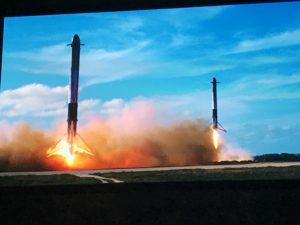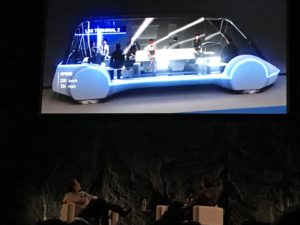
Elon Musk made a surprise appearance on Sunday at SXSW. He sat with Westworld co-creator Jonathan Nolan at the Austin City Limits Moody Theater and answered questions from the audience ranging from his current projects with SpaceX and Tesla, his thoughts on the future, colonizing Mars and energy efficiency.
At the start of the panel, Nolan asked a question from an audience member on how the public can help with getting to Mars.
“In the short term, Mars is really about getting the spaceship built. We’re making good progress on the ship and the booster, code named BFR,” he said. “I think the biggest thing right now, is just general support and encouragement. Once we build it, we’ll have a point of proof—something that other countries and companies can then go and do.”
Musk said once the spaceship has been built and there was a means of getting cargo and people to and from Mars, as well as to and from the moon and other places in the solar system, that is where he felt there would be a tremendous amount of entrepreneurial resources that would be needed.
“You have to build out the entire base of industry,” he said. “Everything that allows human civilization to exist. For the early people that go to Mars, it’ll be far more dangerous.”
He said the early people would be drawn in by the excitement to journey to the frontier and to explore, which would exceed the danger. The early Mars settlers that do go would also need basic fundamental infrastructure to survive, such as a base to create propellant, a power station and blast domes to grow crops. After that is in place, Mars would see an explosion of entrepreneurial opportunities, because the planet would need things from Iron foundries to pizza joints.
Nolan asked Musk what the timeline would be for all of this to built on Mars.
“I’m feeling pretty optimistic about the timeline,” he said. “Although, people have told me before that my timelines, historically, have been optimistic. But I can tell you what I know, currently, is the case, is that we are building the first Mars interplanetary ship, and I think we’ll be able to do short flights probably in the first half of next year.”
The journey to Mars is currently being led by Musk’s SpaceX company that specializes in aerospace manufacturing and space transport services. In February, SpaceX launched the Falcon Heavy, a partially reusable super heavy-lift launch vehicle, which carried a Tesla Roadster as a dummy payload.
Nolan said the question of what to use as the dummy payload was something he and Musk had discussed. They decided it needed to be something that inspired people.
“We wanted to get the public excited about the possibility of something new happening in space—this frontier getting pushed forward,” Musk said. “The goal of this was to inspire you, and make you believe again, just as people believed in the Apollo era that anything is possible.”
During the panel, the audience had an opportunity to see how the mind of an entrepreneur worked. Nolan asked him a question about how he got the idea for his companies, such as SpaceX and The Boring Company, which look at established industries and find a different angle to tackle them.
“I don’t look at things and think, ‘Okay, what’s the rank order of business opportunity from a financial standpoint or anything like that,’” Musk said. “It’s really just, there are some things that don’t seem to be working that are important for our life and for the future to be good.”
Musk said though that for SpaceX and Tesla, he gave his businesses a less than ten percent likelihood to succeed. Nolan asked him, “So why do it?”
“In the case of SpaceX, I kept wondering why we weren’t making progress towards sending people to Mars,” he said. “Why didn’t we have a base on the moon?”
He said it wasn’t happening year after year. The beginnings of SpaceX weren’t just how to create a company, but how to get NASA’s budget to be bigger, which was his initial goal. After SpaceX was founded, he discovered that the biggest issue was the cost of building spacecraft and sending them to space. This led Musk to explore how to make spacecraft cheaper and more efficient to build, and how to make re-usability work.
SpaceX and Tesla did come dangerously close to failing, Musk said. In 2008, he underwent three rocket failures in a row with SpaceX, went through a divorce and Tesla nearly went bankrupt. He was faced with a tough decision: invest his remaining 30 to 40 million in one company and let the other fail, or split his money in both and risk both of them potentially failing.
“When you put your blood, sweat and tears into creating something and building something, it’s like a child,” he said. “I could choose one to let starve to death, and I just couldn’t do it. I split the money between the two. Fortunately, thank goodness, they both came through.”

One of Musk’s newer companies founded in December 2017, The Boring Company, is a travel infrastructure and tunnel construction company. Musk joked to the audience that the company started out as a joke, because he thought it would be a funny name for a company. He then spoke about the inspiration for founding it.
“One day, I was driving down the 405 and I had an epiphany,” he said. “I had been talking about tunnels for four or five years, at least. People would ask me about what opportunities I see in the world and I would say, ‘Tunnels.’”
He said after years of begging people to build tunnels, he decided to build them. The tunnel he started near his SpaceX parking lot is making good progress, he said.
“We’re funding the company through merchandise sales,” Musk said. “Thank you for anyone who bought our flamethrower. You won’t be sorry, or maybe you will. It won’t be boring!” he laughed.
A video showing The Boring Company’s vision for tunnel transportation was then played. The video showed sleek, bus-esque autonomous vehicles transporting people through subway-like tunnels and had the ability to change tracks.
“The Boring Company is, truthfully, only two percent of my time, but about 20 percent of my tweets,” Musk said. “I have fun with The Boring Company, but it really is only about two percent of my time.”
Nolan then asked another question from an audience member regarding artificial intelligence. Musk has publicly expressed concern regarding the dangers of unchecked artificial intelligence research. The audience member asked what Musk believed regarding the concerns around AI research that the other researches who don’t feel the same way don’t believe.
“The biggest issue with AI experts is they think they know more than they do, and they think they’re smarter than they actually are,” Musk said.
He said smart people tend to define themselves by their intelligence and don’t like the idea that a machine can be smarter than them, so they discount the idea, which is fundamentally flawed.
“I’m really quite close to the cutting edge in AI, and it scares the hell out of me,” he said. “It’s capable of vastly more than almost anyone knows, and the rate of improvement is exponential.”
Musk felt AI research should have regulatory oversight to ensure it is being developed safely. He said the dangers from AI were greater than the dangers from nuclear war heads.
“If humanity decides that creating digital super-intelligence is the right move, then we should do so very, very carefully,” Musk said.
Nolan then asked Musk a question from the audience that built on the discussion, “What issues should our next generation of leaders be focused on solving?”
Musk spoke about the importance of interplanetary space travel, especially in the face of a planetary dark age caused by something like World War III, and ensure there’s enough of a seed of people elsewhere—such as Mars, that could bring the world back.
“I think that sustainable energy is also really important,” he said.
After discussing issues currently faced with sustainable energy, Musk and Nolan talked about issues that Musk is currently facing that are stressful for him.
He said Tesla’s Model 3 line of electric cars, and the production problems they’ve faced is stressful, although his team was making good progress on it.
Nolan then asked Musk another audience question, “What do you hope the world will look like for our children when they’re your age?”
“I think, (in the future) we’ve substantially transferred to sustainable generation and consumption of electricity, so the CO2 risk and ocean level rising risk is mitigated,” he said. “For us to have a base on the moon, a base on Mars, be out there exploring the solar system, and a world where anyone could go out to the solar system if they want—to make it really affordable. And that there’s a benign AI and we’re able to achieve a symbiosis with that AI.”
Nolan asked Musk about Starlink, a satellite constellation development project by SpaceX, that the audience asked for more information on.
“Do you mean Skynet?” Musk joked. “It’s intended to provide low latency high-bandwidth air connectivity throughout the world. This is intended to provide people who don’t have any internet connectivity, with internet connectivity.”
He said it would work well for sparsely populated and moderately populated areas, and for giving people in cities a lower cost choice of internet access.
“I think Starlink will be very important in providing the funding necessary for SpaceX to develop interplanetary spacecraft, and at the same time, helping people who have either no or super expensive connectivity, and giving people more of a competitive choice,” Musk said.
At the end of the panel, Kimbal Musk, Elon’s brother and also an entrepreneur joined on stage to discuss the early days of Tesla and how it got started.
“Electric cars are something I’ve been interested in since I was 18 or 19,” Musk said. He came out to Silicon Valley to work on pinnacle research on advanced ultra-capacitors in electric cars. Elon felt it could be a solution to the energy storage problem in electric vehicles.
In 1995, Musk had the choice of working on an energy storage solution for electric vehicles or trying to build a role in the internet, which was taking off. He chose to work on internet companies for awhile, building one of the first online map type companies called Zip2, among other companies like X.com and PayPal. Eventually, he decided to get back to working with electric cars, which was his passion.
“After PayPal went public and got bought by eBay in 2002, that freed up me and a bunch of other people to go out and create companies,” Musk said. “I was debating between solar electric car and space. I thought space would be the least likely to attract entrepreneurial talent. I thought, nobody is crazy enough to do space, so I better do space.”
Musk decided to start with space first, and a year-and-a-half later in 2003, he founded Tesla along with Martin Eberhard and Marc Tarpenning.
At the end of the panel, Nolan, Elon, and Kimbal, sang the song “My Little Buttercup,” from the movie, The Three Amigos. Elon had previously joked about singing the song in a tweet before the session, and the song played when he walked on stage.
